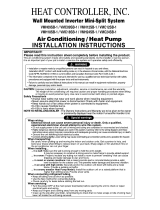4 Room Air Conditioner
Safety Precautions
If strange sound, smell or smoke come from
product, turn the breaker off or disconnect
the power supply cable.
• Otherwise, it may cause electric shock or fire.
Do not put the heater, etc. near the power
cable.
• Otherwise, it may cause fire and electric shock.
Cover the electric part.
• Otherwise, it may cause fire or electric shock.
Do not turn the breaker on/off or
connect/disconnect the power supply plug
during operation.
• Otherwise, it may cause fire or electric shock.
Do not open the suction inlet of the product
during operation.
• Otherwise, it may cause electric shock or
failure.
Do not touch the metal parts of the product
when removing the air filter.
• Otherwise, it may cause personal injury.
Always inspect gas leakage after
installation and repair of product.
• Otherwise, it may cause failure of product.
Install the drain hose to ensure that drain
can be securely done.
• Otherwise, it may cause water leakage.
Keep the level even in installing the
product.
• Otherwise, it may cause vibration or water
leakage.
Do not install the product where the noise
or hot wind from the outdoor unit could
give any casualty to the neighborhood
• Otherwise, it may cause dispute with the
neighborhoods.
Do not step or put anyting on the product.
• Otherwise, it may cause personal injury and
failure of product.
Use a vacuum pump or Inert (nitrogen) gas when
doing leakage test or air purge. Do not compress
air or Oxygen and do not use Flammable gases.
Otherwise, it may cause fire or explosion.
•
There is the risk of death, injury, fire or explosion.
Always intstall an circuit breaker and main
breaker.
• No installation may cause fire and electric
shock.
Do not touch(operate) product with wet
hands.
• Otherwise, it may cause fire or electric shock.























